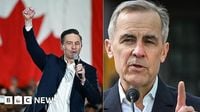A Stunning Reversal of Fortunes in Canada's Historic Election
As Canadians head to the polls, the shadow of President Donald Trump looms large over the campaign, reshaping the political landscape.
At a rally in London, Ontario, on Friday, April 25, 2025, Mark Carney, the Liberal leader, warned that "President Trump is trying to break us so that America could own us." The crowd responded with boos and chants of "Never!" as many waved Canadian flags taped to hockey sticks. Meanwhile, Conservative leader Pierre Poilievre was greeted with enthusiasm at his own rally in the Toronto area, where he rallied supporters with a call to action: "Bring it Home." This slogan not only urged voters to support a change in government but also resonated with a wave of Canadian patriotism amid U.S. tariff threats.
The election, set for Monday, April 28, 2025, comes after a tumultuous few months that have seen a dramatic shift in public sentiment. Just a year ago, the Conservatives held a commanding 20-point lead in national polls over the governing Liberals. However, a series of events, including Justin Trudeau's resignation, Carney's rise to leadership, and Trump's return to the White House, have turned the tide.
By mid-March, national surveys indicated that Carney's Liberals were polling neck-and-neck with the Conservatives, and by early April, they had pulled slightly ahead. This turnaround has been described as a "stunning reversal of fortunes" for the Liberals, who now believe they could secure a fourth consecutive victory and potentially a majority in Parliament.
Carney, a former central banker, is positioning himself as the steady hand needed to navigate these turbulent times. He has emphasized his experience, stating, "It's time for experience, not experiments." His supporters appreciate his calm demeanor and strong resume, viewing him as capable of addressing the threats posed by Trump.
Conversely, Poilievre has focused his campaign on disaffected voters, criticizing what he terms a "Lost Liberal decade" and promising change from a government he blames for the housing crisis and economic sluggishness. This message resonates with voters like Eric and Carri Gionet from Barrie, Ontario, who expressed concerns about their daughters' futures in an increasingly unaffordable housing market.
As the election approaches, the political landscape has become increasingly polarized. While the Liberals and Conservatives dominate the national conversation, smaller parties like the NDP and the Bloc Québécois are struggling to maintain their relevance. In fact, both are facing the possibility of losing seats in the House of Commons as anxious voters flock to the two main parties.
Shachi Kurl, president of the Angus Reid Institute, noted that the departure of Trudeau has allowed disenchanted Liberals to return to the fold. "All of these angry Liberals who are either parking their votes with the NDP or parking their votes with the Conservatives start re-coalescing," she explained. This sentiment is echoed by many voters who feel compelled to act in response to the perceived threats from the U.S.
Trump's late-March announcement of global tariffs on foreign automobile imports provided Carney with an opportunity to step into a leadership role, engaging directly with U.S. officials and showcasing his readiness to handle international relations. In contrast, Poilievre has faced criticism for his combative style and perceived alignment with Trump's rhetoric, which some have labeled as "Trump lite."
As both parties seek to solidify their support, they agree on key priorities, including reducing reliance on the U.S. economy, developing the oil and gas sectors, and increasing defense spending. However, they diverge on who is best suited to lead Canada through these challenges.
Meanwhile, the impact of the U.S.-Canada relationship is being felt on the ground, particularly in regions like the Thousand Islands, where tourism has taken a hit due to rising tensions. The number of travelers entering the U.S. from Canada dropped by almost 900,000 in March 2025 compared to the previous year, a 17-percent decline that has alarmed local businesses.
In the Thousand Islands region, where American and Canadian islands coexist, residents are grappling with a sense of betrayal and confusion about the changing dynamics of their shared community. Tourism has dwindled to a trickle, and many are concerned about the future of their seasonal industries.
As the election draws near, residents on both sides of the border reflect on the evolving political landscape. For many Canadians, the election is not just about choosing a government but also about asserting their identity in the face of external pressures. The upcoming vote will not only determine the direction of Canadian policy but also serve as a referendum on the relationship with the United States.
In this charged atmosphere, the stakes have never been higher. With both major parties vying for the support of a divided electorate, the outcome of the election will shape the future of Canada and its place in the world. As Carney and Poilievre make their final pitches to voters, the question remains: who will emerge victorious in this historic election?





